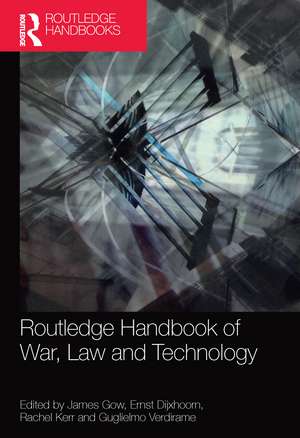Routledge Handbook of War, Law and Technology
Editat de James Gow, Ernst Dijxhoorn, Rachel Kerr, Guglielmo Verdirameen Limba Engleză Paperback – 30 iun 2021
The character of contemporary warfare has recently undergone significant transformation in several important respects: the nature of the actors, the changing technological capabilities available to them, and the sites and spaces in which war is fought. These changes have augmented the phenomenon of non-obvious warfare, making understanding warfare one of the key challenges. Such developments have been accompanied by significant flux and uncertainty in the international legal sphere. This handbook brings together a unique blend of expertise, combining scholars and practitioners in science and technology, international law, strategy and policy, in order properly to understand and identify the chief characteristics and features of a range of innovative developments, means and processes in the context of obvious and non-obvious warfare. The handbook has six thematic sections:
- Law, war and technology
- Cyber warfare
- Autonomy, robotics and drones
- Synthetic biology
- New frontiers
- International perspectives.
This interdisciplinary blend and the novel, rich and insightful contribution that it makes across various fields will make this volume a crucial research tool and guide for practitioners, scholars and students of war studies, security studies, technology and design, ethics, international relations and international law.
Preț: 432.00 lei
Nou
Puncte Express: 648
Preț estimativ în valută:
82.69€ • 89.85$ • 69.50£
82.69€ • 89.85$ • 69.50£
Carte tipărită la comandă
Livrare economică 21 aprilie-05 mai
Preluare comenzi: 021 569.72.76
Specificații
ISBN-13: 9781032092478
ISBN-10: 1032092475
Pagini: 448
Ilustrații: 9 Illustrations, black and white
Dimensiuni: 174 x 246 x 23 mm
Greutate: 0.71 kg
Ediția:1
Editura: Taylor & Francis
Colecția Routledge
Locul publicării:Oxford, United Kingdom
ISBN-10: 1032092475
Pagini: 448
Ilustrații: 9 Illustrations, black and white
Dimensiuni: 174 x 246 x 23 mm
Greutate: 0.71 kg
Ediția:1
Editura: Taylor & Francis
Colecția Routledge
Locul publicării:Oxford, United Kingdom
Public țintă
Postgraduate, Professional, and UndergraduateCuprins
1. Introduction: Technological Innovation, Non-Obvious Warfare and Challenges to International Law Rachel Kerr Part I: Law, War and Technology 2. Obvious and Non-Obvious: the Changing Character of Warfare Ernst Dijxhoorn and James Gow 3. Weapons Law, Weapon Reviews and New Technologies Bill Boothby 4. A Defence Technologist’s View of International Humanitarian Law Tony Gillespie 5. Can the Law Regulate the Humanitarian Effects of New Technologies? Brian Rappert Part II: Cyber Warfare 6. Computer Network Attacks Under the Jus ad Bellum and the Jus in Bello: ‘Armed’ – Effects and Consequences Elaine Korzak and James Gow 7. Computer Network Attacks Under the Jus ad Bellum and the Jus in Bello: Distinction, Proportionality, Ambiguity and Attribution Elaine Korzak and James Gow 8. Proportionality in Cyber Targeting Marco Roscini 9. Digital Intelligence and Armed Conflict after Snowden Sir David Omand 10. The Ambiguities of Cyber Security: Offence and the Human Factor James Gow Part III: Autonomy, Robotics and Drones 11. Autonomy of Humans and Robots Thrishantha Nanayakkara 12. Autonomous Agents and Command Responsibility Jack McDonald 13. Legal-Policy Challenges of Armed Drones and Autonomous Weapon Systems Matthew C. Waxman and Kenneth Anderson 14. The ‘Robots Don’t Rape’ Controversy Maziar Homayounnejad and Richard E. Overill 15. Humanity and Lethal Robots: an Engineering Perspective Tony Gillespie Part IV: Synthetic Biology 16. Biotechnological Innovation, Non-Obvious Warfare and Challenges to International Law Christopher Lowe 17. Synthetic Biology and the Biological Weapons Convention Filippa Lentzos and Cecile Hellestveit 18. A Threat Assessment of Biological Weapons: Past, Present and Future Matteo Bencic Habian 19. The Synthetic Biology Dilemma: Dual-Use and the Limits of Academic Freedom Guglielmo Verdirame and Matteo Bencic Habian Part V: New Frontiers 20. Space Oddities: Law, War and the Proliferation of Space Power Bleddyn Bowen 21. Outer Space and Private Companies: Consequences for Global Security Pawel Frankowski 22. Biometrics and Human Security James Gow and Georg Gassauer 23. Future War Crimes and the Military (1): Cyber Warfare James Gow and Ernst Dijxhoorn 24. Future War Crimes and the Military (2): Autonomy and Synthetic Biology James Gow and Ernst Dijxhoorn 25. Future War Crimes and Prosecution: Gathering Digital Evidence Maziar Homayounnejad, Richard E. Overill and James Gow Part VI: International Perspectives 26. Russian Information Warfare and its Challenges to International Law Oscar Jonsson 27. Unconventional Warfare and Technological Innovation in Islam: Ethics and Legality Ariane Tabatabai 28. Cyber Security, Cyber-Deterrence and International Law: the Case of France Anne-Marie Le Gloannec and Fleur Richard-Tixier 29. The US, the UK, Russia and China (1): Regulating Cyber Attacks under International Law – Developments at the United Nations Elaine Korzak 30. The US, the UK, Russia and China (2): Regulating Cyber Attacks under International Law – the Potential for Dedicated Norms Elaine Korzak
Notă biografică
James Gow is Professor of International Peace and Security and Co-Director of the War Crimes Research Group at King’s College London, UK.
Ernst Dijxhoorn is Assistant Professor in the Institute of Security and Global Affairs (ISGA) at Leiden University, the Netherlands.
Rachel Kerr is Reader in International Relations and Contemporary War and Co-Director of the War Crimes Research Group at King’s College London, UK.
Guglielmo Verdirame is Professor of International Law at the Department of War Studies and the Dickson Poon School of Law, King’s College London, UK.
Ernst Dijxhoorn is Assistant Professor in the Institute of Security and Global Affairs (ISGA) at Leiden University, the Netherlands.
Rachel Kerr is Reader in International Relations and Contemporary War and Co-Director of the War Crimes Research Group at King’s College London, UK.
Guglielmo Verdirame is Professor of International Law at the Department of War Studies and the Dickson Poon School of Law, King’s College London, UK.
Descriere
This volume provides an authoritative, cutting-edge resource on the characteristics of both technological and social change in warfare in the 21st century, and the challenges such change presents to international law.
